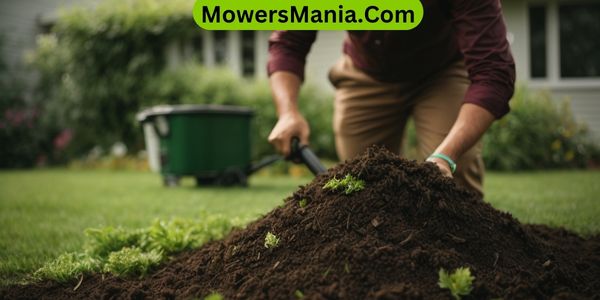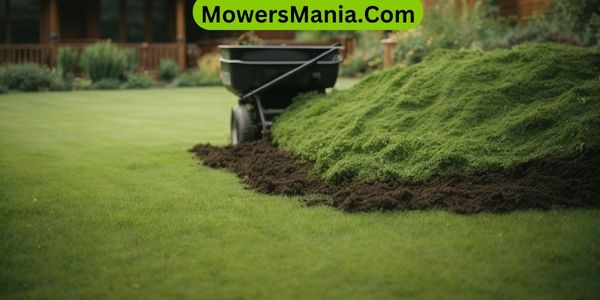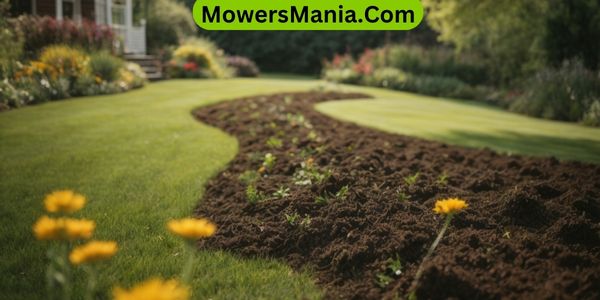If you want to give your lawn a boost, topdressing with compost is the way to go. It’s a simple and effective way to improve soil health, promote lush growth, and reduce thatch buildup.

In this article, we’ll show you how to topdress your lawn with compost, step by step. You’ll learn the benefits, best practices, and everything you need to know to keep your lawn looking its best.
Benefits of Topdressing With Compost
You can experience significant improvements in soil structure, moisture retention, and overall lawn health by topdressing your lawn with compost.
Compost is rich in organic matter, which helps to improve soil structure by providing essential nutrients and promoting beneficial microbial activity. This, in turn, creates a healthier environment for your grass to thrive.
Additionally, the organic matter in compost acts like a sponge, helping the soil to retain moisture more effectively. This can be particularly beneficial during dry periods, as it reduces the need for frequent watering and helps your lawn to stay green and lush.
Moreover, topdressing with compost can also enhance the overall health of your lawn by suppressing diseases, reducing thatch buildup, and promoting a robust root system. The natural nutrients found in compost contribute to stronger, more resilient grass that’s better equipped to withstand environmental stresses.
Choosing the Right Compost
Finding the right compost for topdressing your lawn is essential for achieving optimal results. When selecting compost, it’s crucial to consider the source of the materials used.
Look for compost made from a variety of organic matter, such as grass clippings, leaves, and kitchen scraps. This diverse mix ensures a wide range of nutrients and beneficial microorganisms that will enrich your soil.
Additionally, check if the compost has been properly cured and aged. Well-aged compost is dark, crumbly, and earthy-smelling, indicating that it has fully decomposed and is ready to enhance your lawn without the risk of burning the grass.
It’s also important to assess the texture of the compost. You want a fine, uniform texture that will spread evenly over your lawn, providing consistent coverage. Coarse or lumpy compost may create uneven patches and hinder the overall effectiveness of the topdressing process.
Lastly, consider the nutrient content of the compost. Look for a balanced blend that includes nitrogen, phosphorus, and potassium, as well as essential micronutrients like calcium and magnesium.
By carefully evaluating these factors, you can select the right compost to revitalize and nourish your lawn, promoting healthy growth and vibrant greenery.
Steps for Topdressing Your Lawn

After choosing the right compost, proceed with the next step of topdressing your lawn to rejuvenate its health and appearance.
Follow these simple steps to ensure an effective topdressing process:
| Step | Instructions |
|---|---|
| 1 | Mow the lawn to a short height, around 1 to 1.5 inches. This helps the compost make direct contact with the soil. |
| 2 | Spread the compost evenly over the lawn using a shovel, rake, or topdressing spreader. Aim for a layer of about 1/4 to 1/2 inch thick. |
| 3 | Work the compost into the grass by gently brushing it in with a broom or the backside of a rake. This helps the compost reach the soil and prevents it from sitting on top of the grass. |
| 4 | Water the lawn thoroughly to help the compost settle into the soil. Aim for about 1 inch of water to ensure the compost is properly integrated. |
| 5 | Monitor the lawn’s progress and apply more compost as needed in thin or patchy areas. Avoid over-application, as this can suffocate the grass and lead to issues. |
Best Practices for Topdressing
To achieve optimal results when topdressing your lawn with compost, it’s essential to adhere to best practices for the process.
First and foremost, ensure that the compost you use is well-aged and free from any weed seeds. This will prevent unwanted plants from sprouting in your lawn.
When applying the compost, do so evenly across the entire area, using a rake to spread it out in a thin layer. Avoid piling the compost too thickly in one spot, as this can suffocate the grass underneath.
Additionally, it’s crucial to time the topdressing properly. Aim to do it in the early spring or fall when the grass is actively growing, allowing it to incorporate the compost more effectively.
After topdressing, gently water the lawn to help the compost settle into the soil. Keep in mind that overwatering can wash away the compost, so be mindful of the amount of water you use.
Maintaining a Topdressed Lawn

Your lawn’s topdressing’s maintenance requires regular mowing and watering to ensure the compost integrates properly with the soil and promotes healthy grass growth.
After topdressing your lawn with compost, it’s essential to maintain a consistent mowing schedule. Keep your grass at the recommended height for your specific grass type, usually around 2.5 to 3.5 inches.
Mowing too short can stress the grass and hinder its ability to establish deep roots, while mowing too infrequently can lead to thatch buildup, preventing the compost from reaching the soil.
Watering is another crucial aspect of maintaining a topdressed lawn. Ensure your lawn receives about 1 to 1.5 inches of water per week, including rainfall.
Deep, infrequent watering encourages the roots to grow deeper into the soil, enhancing the overall health of your lawn. Be mindful of the moisture levels and adjust your watering schedule as needed, especially during hot and dry periods.
Keep an eye out for any signs of compaction or excessive thatch, and consider aerating the lawn if necessary. Regular maintenance will help the compost integrate effectively, allowing your lawn to thrive.
Frequently Asked Questions (FAQs)
Can I Topdress My Lawn With Compost During Any Season, or Is There a Specific Time of Year That Is Best?
You can topdress your lawn with compost during any season, but it’s best to do so in the late summer or early fall. This will help your grass absorb the nutrients and improve the soil for the next growing season.
Is It Necessary to Aerate My Lawn Before Topdressing With Compost, and if So, How Often Should I Aerate?
Yes, it’s necessary to aerate your lawn before topdressing with compost. Aerate once a year for cool-season grass, and twice a year for warm-season grass. This allows the compost to penetrate the soil and promote healthier grass growth.
What Are Some Common Mistakes to Avoid When Topdressing a Lawn With Compost?
When topdressing your lawn with compost, avoid applying too much compost at once, as it can suffocate the grass. Additionally, ensure the compost is well-cured to prevent weed seeds from germinating and spreading throughout your lawn.
Are There Any Specific Types of Grass or Soil Conditions That May Not Benefit From Topdressing With Compost?
In certain cases, specific grass types or soil conditions may not benefit from topdressing with compost. It’s essential to consider factors like soil pH, drainage, and grass species to determine if compost topdressing is suitable for your lawn.
How Long Should I Wait After Topdressing With Compost Before Mowing My Lawn?
After topdressing with compost, wait at least a week before mowing your lawn. This allows the compost to settle and integrate with the soil, promoting healthy growth and minimizing the risk of disturbing the newly added compost.
Conclusion
So, go ahead and give your lawn the love it deserves by topdressing it with compost. Not only will it improve the health and appearance of your grass, but it will also benefit the soil and environment.
Remember to choose the right compost, follow the proper steps for topdressing, and maintain your lawn regularly.
With a little effort, you can have a lush, green lawn that will be the envy of your neighborhood.



